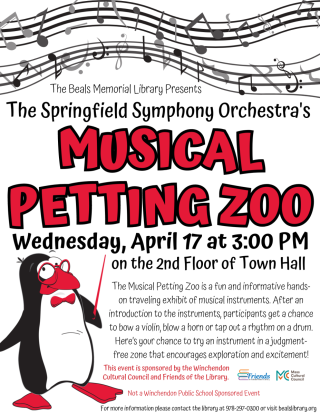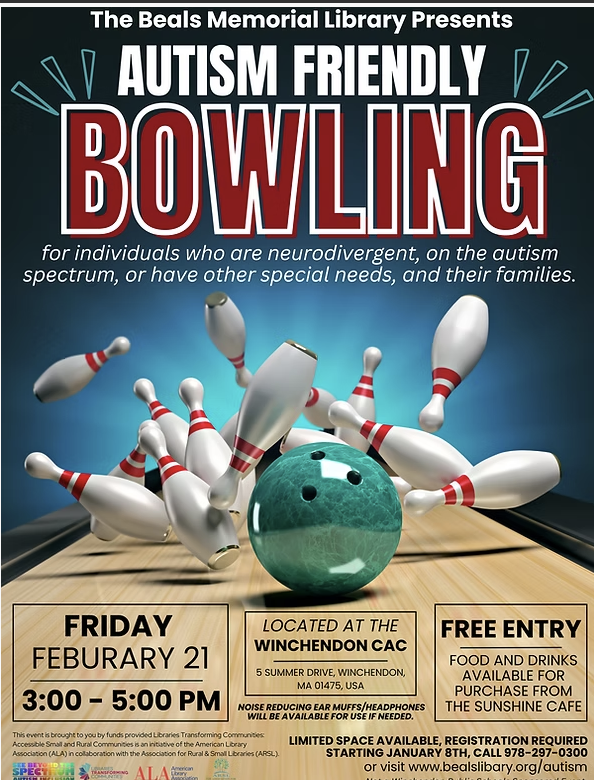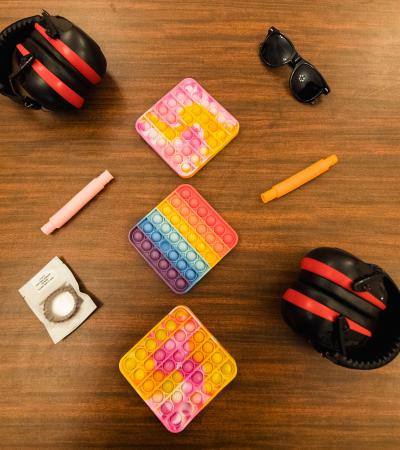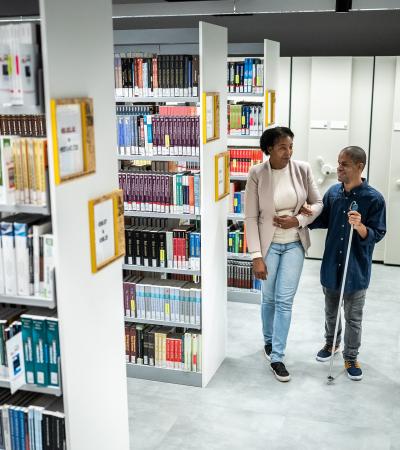Sensory-Friendly Programming is Urgently Needed

Without a doubt, the most important lesson LTC grantees have learned from their efforts to create sensory-friendly programs is that the need for such programs is immense. Speaking specifically of the need for ASD inclusion efforts, Beals Memorial Library director Manuel King says that upon embarking upon this work, libraries will “find that there are way more people in your town, city, or neighborhood on the spectrum than you ever imagined.” “The ASD community is bigger than you think,” adds Beals assistant library director Alexis Chanthachack. Since beginning their “See Beyond the Spectrum” initiative, Beals staff member Kayla Charlonne (who identifies as neurodivergent) says she has spoken with many community members whose presence on the autism spectrum she was previously unaware of.
Whenever offered, individuals and families have been deeply appreciative of the effort to meet the needs of community members with sensory sensitivities. At the Erving Public Library in Erving, MA, staff expected that their sensory-friendly programs would be “slow to take off.” But that wasn’t the case at all. “From the very beginning,” the library shared, “people flocked to [these programs], which was a delightful surprise.”
At the Boylston Public Library in Boylston, MA, staff also found that their efforts were addressing an urgent need within the community. The library hosted a variety of programs specifically for neurodivergent individuals — including a sensory-friendly magic show and a ziplining program (held at a facility that is right next door!) inspired by research demonstrating the benefits of structured physical activities for individuals with ASD. Even though these were “big ticket” programs, both hit full capacity, and participants raved about their experiences. The process “showed us that parents appreciate simply having a ‘sensory-friendly’ consideration,” the library noted. As a result, they are now implementing sensory-friendly options in all of their programs.
The Beals Memorial Library’s experience has been similar. Parents often need help finding resources, director King explains — and are sometimes desperate for places to take their children that are “non-judgmental and welcoming.” As evidence of this, a Friend of the library shared the story of a mother who journeyed to the library from a town twenty-five minutes away just to give her child a chance to participate in a sensory-friendly program. During the program, the mother “burst into tears because people finally understood what she was going through with her own kids.”
Sensory-Friendly Programs Benefit Patrons of All Ages
Though often designed with youth in mind, sensory-friendly programs can benefit individuals of all ages. At the Beals Memorial Library, staff witnessed this firsthand when neurodivergent adults began attending events initially designated as children’s programs. In combination with the recognition that more and more people are being diagnosed with ASD (and other types of neurodivergence) later in life, this experience convinced the library to stop creating programs for specific ASD audiences. Now, its sensory-friendly programs are open to all.
A similar sequence of events unfolded at the Erving Public Library in Erving, MA. After seeing an announcement about their LTC grant in a local newspaper, community members from a program that serves adults with intellectual and developmental disabilities began coming to the library — even before staff had begun any new programming! This pattern has persisted to the present day. These patrons now refer to Monday as “Library Day,” staff explain; the first day of every week, between six and 15 adults come to the library to color, play board and card games, do jigsaw puzzles, socialize with other community members, enjoy a snack, and borrow materials.
Staff at the Ashland Public Library in Ashland, OH also learned the value of age-inclusive programming. Upon receiving an LTC grant, the library’s initial aim was to create programs for older adults who identify as neurodivergent. After some consideration, however, staff decided to modify their approach, and began rebranding their programs as “all ages.” This adjustment helped the library attract a wider audience — including individuals from local facilities that work with adults who have developmental disabilities.
Sensory-Friendly Programs Benefit Caregivers, Families, and Communities
In addition to benefiting neurodivergent individuals of all ages, sensory-friendly programs can create a ripple effect through families and entire communities. Through their efforts, small and rural libraries are showing people with sensory sensitivities that they are not alone. At the Beals Memorial Library, neurodivergent staff member Kayla Charlonne says that her experiences have shown her that “more people understand the struggle I go through than I thought.”

Families and caregivers can also build community and develop a sense of solidarity with each other — something that the Ashland Public Library in Ashland, OH has seen firsthand. One of the library’s goals is to “raise awareness within the community about dementia and depression,” and to “dispel myths and reduce stigmas associated with these conditions.” Through their sensory-friendly programs, staff note, the library has “successfully encouraged family members and caregivers to participate alongside individuals. By creating a welcoming and inclusive environment,” they add, “we hope to have strengthened familial bonds and provided opportunities for shared experiences.”
Libraries can also play a role in educating other community organizations on the importance of sensory-friendly programs — and on how to create them. Within the community, the Beals Memorial Library is known as a leader in the design of sensory-friendly programs; other organizations routinely approach staff for information, resources, and training. By developing partnerships with these organizations, the library is amplifying its efforts and deepening its impacts; indeed, there is now a consensus that what’s happening at the library is spreading through the community. And as they help generate more widespread community buy-in, the library’s partnerships are also creating a sense of shared responsibility for programming, meaning that other organizations are helping sustain the library’s work.
Sensory-Friendly Resources and Practices Can Also Be Incorporated into Regular Programs

At times, there is a need to design programs specifically for those with sensory sensitivities. When significant modifications would need to be made to prevent activities from being overstimulating, the best approach is to create a parallel sensory-friendly experience. Similarly, when there is a need to prevent unwanted public attention, stigmas can be reduced by restricting a program’s audience to those with ASD or other types of neurodivergence.
But in many cases, it is possible to integrate sensory-friendly resources and practices into pre-existing programs. And often, these modifications can be made without significantly increasing the cost of a given program. As Alexis Chanthachack of Beals Memorial Library puts it, “small but meaningful accommodations can go a long way.” For example, by making headphones available for a “Musical Petting Zoo” program they held with the Springfield (MA) Symphony Orchestra, staff at Beals ensured that all patrons could enjoy the experience.

Accessibility can also be improved by making a common set of sensory-friendly materials available for general use. At all of the Beals Memorial Library’s programs, staff make use of a “sensory box” complete with fidget toys, headphones, and other items that help neurodivergent individuals self-regulate. Items like these are inexpensive, Charlonne notes, “but they make such a big difference for anyone who is getting overstimulated.” Similarly, in the adult, teen, and children’s sections within the Boylston Public Library in Boylston, MA, staff have created stations stocked with a variety of “Focus Tools” — age-appropriate items such as timers, fidget toys, meditation devices, light-reducing glasses, communication cards, and stretch bands.
When determining what the best approach to sensory-friendly programming is, it is best to begin with a simple question: to what extent can neurodivergent individuals access all of our current offerings?
Sensory-Friendly Programs are Best When Planned with Neurodivergent Community Members

Co-creating programs with individuals who identify as neurodivergent may not always be feasible. But whenever possible, it is best to follow the maxim “Nothing About Us Without Us.” By actively involving neurodivergent patrons in the planning process, libraries can ensure that their programs effectively meet community needs and reflect the interests and concerns of its neurodivergent members.
LTC libraries have had success with this approach. At the Beals Memorial Library, staff planned a “Touch a Truck” event in conjunction with a young adult who had been diagnosed with ASD during their senior year of high school. Since learning about the library’s LTC grant, this individual had been interested in contributing to program planning. For this event, staff simply gave instructions to participants; everything else was handled by the community member. The event was a complete success, and produced a great turnout.
Staff at the William B. Harlan Memorial Library in Tompkinsville, KY have also successfully brought neurodivergent community members into their program planning efforts. To engage children who enjoy activities that include sorting, matching, puzzles, stories, and art, the library installed an interactive scavenger hunt mural - one complete with a puzzle key and coloring sheets. The mural was designed and painted by two of the library’s autistic patrons (one an adult, and the other a child).
Sensory-Friendly Programs Work Best When Offered as a Regular, Consistent Part of Libraries’ Public Offerings
Community responses to LTC libraries’ sensory-friendly programming efforts have been incredibly positive. Attendance at sensory-friendly programs has generally been high, and as the examples shared above indicate, families are often willing to travel a great distance to participate in these programs. But as with all programs, attendance can fluctuate. Given the challenges of caring for individuals with ASD, there are often instances in which families and individuals are simply unable to attend scheduled events.

This should not be taken as evidence of disinterest, or of a program’s failure to benefit its target audience. Numbers do not provide a true sense of impact, which makes having ways to capture how much these offerings impacted patrons, families, and library staff critical in telling the story of sensory-friendly events. As the experiences of those who attend the ASD caregiver support group held at the Beals Memorial Library indicate, programs can be incredibly meaningful even if they only include a few individuals. Beyond this, it bears noting that it is often hard to know when a particular program will be needed, or to predict in advance how many individuals will participate. Given these realities, consistency is key. The best results come when sensory-friendly programming efforts are made a regular part of the library’s schedule of events.
Sensory-Friendly Programs Work Best When Accompanied by Staff Training
Staff training is an invaluable component of any attempt to make library programs more accessible to neurodivergent patrons. Through training, library workers can gain a better understanding of neurodivergence, become more knowledgeable on how to effectively assist and interact with neurodivergent patrons, and gain confidence and comfort in providing sensory-friendly programs. Training can also open doors to acquiring new skills — for example, through the ASL classes that are offered to staff (and community members) at the Beals Memorial Library.
At the Joeten-Kiyu Public Library in the Northern Mariana Islands, staff have made an intense commitment to training. The library used its LTC grant to hire instructors who taught classes geared toward increasing staff capacities in the development of programs for children with ASD (along with their families). As the library noted, when it comes to programming, “the challenge is having certified staff who are trained to service and provide one-on-one support.” To meet this challenge, staff completed over 150 hours of professional development coursework — which included topics such as autism awareness and disability etiquette.
The Boylston Public Library in Boylston, MA also set aside part of its LTC grant for staff training. The library’s goal was to equip staff with “the knowledge and tools to understand the unique needs of [neurodivergent patrons” in ways that would help them “intentionally integrate new services into our normal operations.” Delivered through a variety of free online resources, the training “proved to be extremely valuable.” Staff were “revitalized” by the experience, and the training led to “a lot of brainstorming” about ways to implement their grant. As a result, the library developed a number of “creative public programs that proved very successful.” At the same time, the training improved staff approaches to interacting with and serving patrons.
Let’s Put it to Work!
Through their accessibility work, small and rural libraries are effectively creating a set of best practices for designing and implementing sensory-friendly programs. The lessons they’ve learned can benefit neurodivergence inclusion efforts in a wide array of public settings, and can contribute to the creation of a society that better meets the needs of individuals with sensory sensitivities.
If you’ve worked in a library that provides sensory-friendly programs, we’d love to hear about your experiences! To share your story, you can write to programminglibrarian@ala.org.
About this Article
This article was written by Knology – evaluator of the LTC Access initiative. The article is part of a series of blog posts exploring how libraries that received LTC Access funds are working to better meet the needs of patrons with disabilities.
In other posts in this series, we provide a general overview of the accessibility projects these libraries have launched, look at attempts to put the disability rights movement’s ethic of “Nothing About Us Without Us” into practice, consider efforts focused on neurodivergent patrons and older adults, and look at how small and rural libraries are creating accessible community conversations. You can also read about how these libraries are overcoming challenges to planned accessibility upgrades, building partnerships to address community accessibility needs, and improving patrons’ experiences. And for stories of what individual libraries are doing, see the case studies we’ve published about the accessibility work going on at the Lee Public Library, Jessie E. McCully Memorial Library, Beals Memorial Library, and Bixby Memorial Free Library.
For more on how libraries can become more accessible to patrons with disabilities, see the collection of resources we assembled.
Photos courtesy of Pattianne Stone Photography and the Beals Memorial Library



